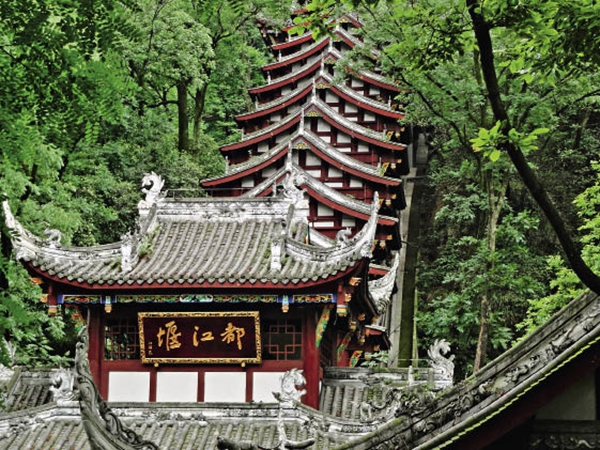Chengdu – Capital of West China
China Today by Bill Brown, November 10, 2016 Adjust font size:

The 2,200-year-old Dujiangyan Irrigation Project.
Dujiangyan is not a dam but a unique structure that diverts some water to fields but allows most to flow freely. This enables water transport, as well as the natural migration of fish. In the U.S., environmentalists are destroying century-old dams and local agriculture as well, in efforts to protect endangered fish or frogs. Sichuan’s 2,200-year-old UNESCO World Heritage Site is a lesson on how to steward our fragile little planet while improving, rather than destroying, economies and livelihoods.
Dujiangyan made Sichuan the “Birthplace of China” because its agriculture fed the vast armies of Emperor Qin Shi Huang (259-210 BC), who unified China in 221 BC and started building the 10,000-li (5,000 km) Great Wall the following year. And each year on Tomb-Sweeping Day (usually April 5, my birthday!) locals dress in ancient costumes and read eulogies in commemoration of its builders.
Chengdu was in the Tang Dynasty (618-907) one of China’s most important commercial cities, but also well known for its arts, sciences, and education. In 141 BC, local governor Wen Weng established China’s first public schools in Chengdu. In the Tang Dynasty, Chengdu attracted famous artists and poets such as the legendary romantic poet Li Bai. To this day, Chengdu is known for its arts, including Zaju Opera – a lively mix of singing, dancing, and poetry first performed in Chengdu – and Sichuan Opera, with its amazing Bianlian (face changing) and fire breathing (though after eating Sichuan food, I, too, breathe fire).
For around 2,000 years, Chengdu was also known as the Brocade City because the richly decorative shuttle- woven silk fabric it produced was worn by royalty. Today, you don’t have to be part of the elite to wear Chengdu brocade. A fascinating place to buy it is Jinli Street, which has been a popular commercial thoroughfare for around 2,300 years.
The buildings along Jinli Street, with their wooden fronts and balconies festooned with festive Chinese lanterns, reflect west Sichuan architecture. On this lively street are restaurants, classic teahouses with bamboo chairs and wooden tables, handicrafts and specialty shops, and of course vendors hawking selections from Chengdu’s 100 or more street snacks. But for those who prefer more modern shopping, there’s downtown’s Chunxi Road which, built in 1924, is brand new by Chengdu standards.
It is no surprise that China’s “breadbasket” is famous for cooking. I thought it had only two flavors, hot and hotter, but Sichuan chefs claim there are seven: sweet, sour, salty, bitter, spicy, and tongue-numbing. Many dishes combine several flavors in one. Twice-cooked pork, Mao Zedong’s favorite in his twilight years, is salty, sweet, spicy and aromatic – not only tongue-numbing but mind-numbing.